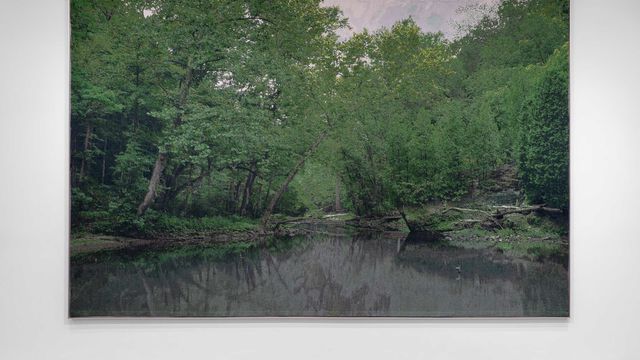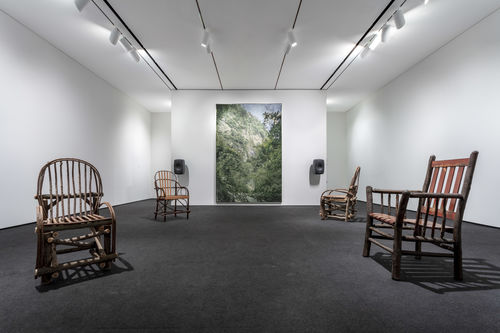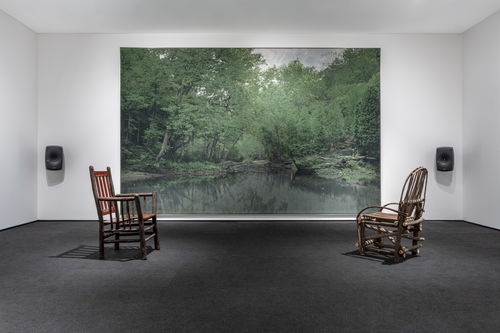
Hammer Projects: David Hartt
- – This is a past exhibition
David Hartt’s The Histories (Old Black Joe) (2020) centers on two jacquard-woven tapestries and a quadraphonic soundtrack arranged by the legendary musician Van Dyke Parks. The installation brings together three disparate figures from the nineteenth century: the self-taught American landscape painter Robert S. Duncanson (1821–1872), the only Black member of the Hudson River school; Michel-Jean Cazabon (1813–1888), the first internationally recognized painter from Trinidad; and Stephen Foster (1826–1864), a white American composer whose song “Old Black Joe” has endured as a dying slave’s lament even though the bulk of Foster’s musical output was written for blackface minstrel shows. The shared space of Hartt’s installation offers an opportunity to study and listen to cultural pasts once removed, reflecting on the history of empire, postcolonial identity formation, and the roles of painting and music at the intersections of race and geography.
Hartt’s tapestries are based on the location depicted in Duncanson’s famed painting Blue Hole on the Little Miami River (1851) and the Maracas Falls in Trinidad, a site represented in several of Cazabon’s paintings. Using a similar methodology of translation and reinterpretation, Hartt recruited the producer and arranger Van Dyke Parks (known for his work with Randy Newman, the Beach Boys, and Joanna Newsom, to name a few) to produce a calypso-inspired rendition of Foster’s “Old Black Joe.” Parks has long championed the contributions of Black musicians and performers, producing albums for Mighty Sparrow and the Esso Trinidad Steel Band among countless others. By reimagining one of Foster’s best- known musical works—a song that was praised by no less than the sociologist W. E. B. Du Bois in his seminal text The Souls of Black Folk (1903)—Parks returns “Old Black Joe” to a Black musical idiom rooted in the Caribbean, where much of the story of colonial expansion took shape. Hartt’s installation questions the underlying myths of modernism in the Americas, examining the lasting effects of colonial empire and the complex interplay between geography and culture in the shaping of these narratives.
The Histories (Old Black Joe) is the second chapter of Hartt’s three-part cycle begun in 2019. The first part, The Histories (Le Mancenillier), was commissioned by the Beth Sholom Preservation Foundation and initially installed in the historic Frank Lloyd Wright–designed Beth Sholom Synagogue in Elkins Park, Pennsylvania. The third chapter, The Histories (Crépuscule), was commissioned by the Philadelphia Museum of Art and opened there in spring 2021.
BIOGRAPHY
David Hartt (b. 1967, Montreal) lives and works in Philadelphia, where he is associate professor in the Department of Fine Arts at the University of Pennsylvania. Hartt's recent solo exhibitions include My Building, Your Design: Seven Portraits by David Hartt, Art Institute of Chicago (2018); in the forest, Graham Foundation; Chicago (2017); and Interval, LAXART, Los Angeles (2015). His work has been included in such group exhibitions as Ocean of Images: New Photography 2015, Museum of Modern Art, New York; America Is Hard to See, Whitney Museum of American Art, New York (2015); and Shine a Light: Canadian Biennial 2014, National Gallery of Canada, Ottawa. Hartt is the recipient of a 2015 Foundation for Contemporary Arts Grant. In 2012 he was named a United States Artists Cruz Fellow, and in 2011 he received a Louis Comfort Tiffany Foundation Award.
Essay
By Aram Moshayedi
The history of art withholds the stories of past lives obscured by the visibility of others. The art historical canon has proven to be mutable—eventually accommodating those who had previously been omitted—but canonization is not without its issues. In the move toward recuperation and revision, a case for a given artist’s value is often made on the grounds of exceptionalism, and subjectivities that were once fluidly mobile and unfixed are transformed into rarified specimens. This stabilizing activity most often takes place around race, ethnicity, gender, and sexuality in attempts to provide a broader and more inclusive view of art’s past. The role of the historian is to subdue the disorder of otherwise unwritten histories through methodologies of narration and curation. Scholarly publications and museum exhibitions expand the canon just as much as they render artists and works of art as unique, singular entities of stylistic and formal congruity. The origins of this historical ordering—often identified with the fifth-century BCE Greek historian Herodotus and his chronicling of the Greco-Persian Wars in the Histories—precede the discipline of art history yet inform how the stories of art and culture’s many pasts are told.
In a trilogy of recent works, the artist David Hartt channels the figure of Herodotus in order to reflect on the more recent histories of modernity, colonial empire, and their aftermaths. Hartt asks: How do these histories inhabit the present moment? What cultural memories linger in the experience of contemporary life? The series title—The Histories—establishes a connection to Herodotus, which Hartt’s project identifies as a foil for understanding the European colonial project of the nineteenth century. Beginning in 2019 with The Histories (Le Mancenillier), Hartt’s project has assembled disparate cultural figures from visual art, literature, and music. The casting in each chapter offers a discrete and unlikely grouping of identities that are referenced in tightly choreographed pairings of image and sound. The result is an oblique art historical reprisal that extends the lives of Hartt’s subjects—artists, composers, and writers—into the vernacular of the twenty-first century.
The Histories (Le Mancenillier) was presented within the context of the Frank Lloyd Wright–designed Beth Sholom Synagogue in Elkins Park, Pennsylvania. Woven tapestries, high-resolution video, and sound reimagined the legacies of the American landscape painter Martin Johnson Heade (1819–1904) and the American composer Louis Moreau Gottschalk (1829–1869), whose composition for piano Le Mancenillier, along with other works, has been reinterpreted by the Ethiopian pianist Girma Yifrashewa. Gottschalk was of mixed Jewish, French Caribbean, and Creole descent, and his background represents the kind of composite identity that has since become characteristic of diasporic life. Mancenillier is the French name for the manchineel tree, a species native to the Caribbean that might not otherwise be known to the tradition of Western music. Musically the composition for piano takes some inspiration from the syncopated rhythms of Creole folk music while bathing in the emotive glow of the romantic era. Gottschalk is the conduit through which seemingly opposed melodic traditions combine, and the adaptation of his scores for piano by Yifrashewa—a classically trained pianist whose work has retained the musical influences of his native Ethiopia—only contributes to the wealth of cultural accumulation at play throughout The Histories (Le Mancenillier). The specifics of Gottschalk’s biography are thus layered with Yifrashewa’s life history in order to underscore the cross-cultural impacts of migration and movement, whether they be forced or otherwise.
Two jacquard-woven tapestries and a quadraphonic soundtrack arranged by the legendary musician Van Dyke Parks occupy the conceptual center of The Histories (Old Black Joe), the second chapter in Hartt’s three-part cycle. Much like The Histories (Le Mancenillier), the installation brings together disparate figures from the nineteenth century: the self-taught American landscape painter Robert S. Duncanson (1821–1872), the only Black member of the Hudson River school; Michel-Jean Cazabon (1813–1888), the first internationally recognized painter from Trinidad; and Stephen Foster (1826–1864), a white American composer whose song “Old Black Joe” has endured as a dying slave’s lament even though the bulk of Foster’s musical output was written for blackface minstrel shows. Hartt’s gesture here, as elsewhere, is recuperative in nature. Reflecting not only on the history of empire, postcolonial identity formation, and the roles of painting and music at the intersections of race and geography, the work offers an opportunity to study and listen to—specifically to sit with—cultural pasts once removed.
The tapestries’ imagery is based on the location depicted in Duncanson’s famed painting Blue Hole on the Little Miami River (1851)—now in the collection of the Cincinnati Art Museum—and the Maracas Falls in Trinidad, a site represented in several of Cazabon’s paintings. Before the images were translated into woven tapestries in Wielsbeke, Belgium, Hartt traveled to Ohio and Trinidad to photograph the natural settings from vantage points once occupied by the original painters. By physically reinhabiting these locales, Hartt placed himself in historical proximity to Duncanson and Cazabon, artists whose racial makeup would certainly have been uncommon within their respective milieus. The translation of painting to photograph to tapestry represents the formal accretion of historical modes of representation, of imaging technologies, and of identities that have historically been denied access to the means of reproduction—the end results of which, with their jacquard-woven detail, compete with the “power and spectacle of history painting,” in Hartt’s words.1
Using a similar methodology of translation and reinterpretation, Hartt recruited the producer and arranger Van Dyke Parks (known for his work with Randy Newman, the Beach Boys, and Joanna Newsom, among others) to produce a calypso-inspired rendition of Foster’s “Old Black Joe.” Parks has been an advocate for the work of Black musicians and performers, producing albums for the likes of Mighty Sparrow and the Esso Trinidad Steel Band. By reimagining one of Foster’s best-known musical works, Parks returns “Old Black Joe” to a Black musical idiom rooted in the Caribbean, where much of the story of colonial expansion took shape. The musician and ethnomusicologist Michael E. Veal recently described Parks’s contribution as a “collagist deconstruction” of the original, composed of so many fragmented parts: “Parks does everything within his musical power to subvert the song’s original unity and thematic resonances.”2 Certainly Parks pulls one musical idiom from another in a quivering battle between steel drums, parlor piano, whammy bars, and swelling string arrangements. Parks’s musical intervention resembles a sonic game of tug-of-war, with composition on the one side and self-sampled musique concrète on the other.
The Histories (Old Black Joe) encourages deep listening, just as much as it does attentive viewing. The installation of tapestries and sound is accompanied by a suite of chairs that Hartt modeled on one included in a photograph of Duncanson taken by William Notman in 1864. Sitting in the semirelaxed posture afforded by the chairs changes the relationship of one’s body to the work of art. The portrait of Duncanson is animated by this gesture, which seats the viewer-listener in a proximate relation to Duncanson’s biography—the wooden chair acting as an intermediary between historical moments.
The third and final chapter in Hartt’s series, The Histories (Crépuscule), similarly bridges the unlikely movements and migratory patterns of subjectivities and modes of thought across eras. Focused on the regions of Newfoundland and Jamaica, the suite of works spans a more circuitous network of personal references than the other installations. Allusions to the structural filmmaker Michael Snow, the artist Isa Genzken, and the Jamaican classical composer Oswald Russell (1933–2012) abound within The Histories (Crépuscule). The work’s historical lynchpin is the American painter Frederic Church (1826–1900), whose sketches from an expedition to Newfoundland and Labrador in 1859 serve as source material. Together the works in the series form a complex of associations that interweave the histories of nineteenth-century colonial expansion and the social lives that emerged from it. The biographical web formed by Hartt’s The Histories series is one in which individual subjectivities erode the stable narratives of historical progress and change. These so-called minor histories, in their divergence from the dominant narratives of the European colonial past, are the revelations that inform the experience of cultural forms today.
Notes
1. David Hartt, in “The Big Dig: David Hartt, The Histories (Old
Black Joe): David Hartt in Conversation with John Corbett,”
Corbett vs. Dempsey, https://corbettvsdempsey.viewingrooms.com
/viewing-room/9/.
2. Michael E. Veal, “Six Black Atlantic Dances,” in The Histories: David Hartt (New York: Distributed Art Publishers, 2021), 82–84.












